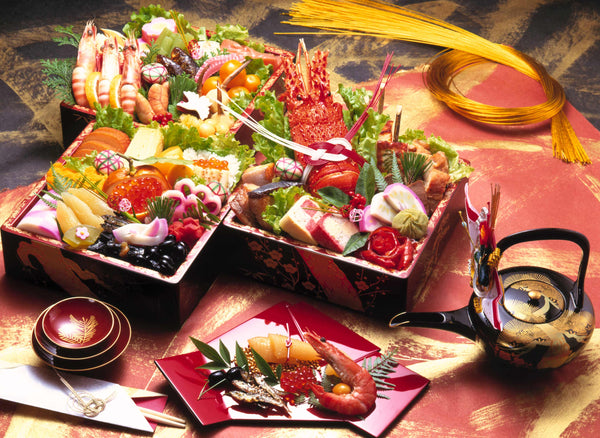Your Cart is Empty
Free Shipping on All Subscriptions Worldwide

Of all the holidays in Japan, the New Year Shogatsu (正月) celebration is the most important. Like Christmas in the West, it is a holiday for families to spend time with each other. The ancient Japanese believed that Toshigami-sama (年神様), or year god, visited their homes at the beginning of every year. From this belief, many Japanese New Year’s traditions were born, such as visiting a shrine on January 1st to pray and give offerings, to cleaning your house in the annual year-end cleanup called ‘nenmatsu no osoji‘ (年末の大掃除). The most exciting and delicious of these traditions is preparing and eating the Osechi-Ryouri (御節料理).

Historically, it was taboo to cook using hearth ware or work during the first 3 days (called Sanganichi 三が日) of the new year. Because of this, women spent days preparing extravagant long-lasting meals for the entire family. Since the meal was also to be presentable to the Toshigami-sama, it is carefully prepared and packed in decorative lacquer boxes called Jubako (重箱).

Jubako (重箱)
Today, many people buy Osechi-Ryouri from restaurants and supermarkets. Most stores start accepting reservations for their Osechi from October, and it can cost anywhere from $50 to $10,000.

$210 Osechi advertisement
Whether the Osechi is handmade or store bought, they are all delicious, beautiful, and each food item has a special meaning celebrating the New Year. Let's take a look at what each of the food represents:

From the top, left to right:
Kuromame (黒豆):Sugar and soy sauced marinated black soy beans. Mame sounds like the word for health and diligence, so eating this during the New Year’s is a symbol of good health.
Ebi (エビ) : Sake simmered shrimp symbolize longevity, since the shrimp’s bent waist and antennae look like an elderly hunched man with a long beard.
Lotus Root (レンコン):Lotus roots extend through the mud and water to blossom the beautiful lotus flower. Because of this, they are an important symbol in Buddhism, representing progress of the soul. Also, since a lotus root contains holes, it also symbolizes having an unobstructed view of the future.

Mini Osechi Ryouri
Japanese Kumquat/Bitter Daidai Orange (橙):Daidai written with a different kanji (代々) means ‘from generation to generation,’ so eating this symbolizes a blessing for fertility.
Kurikinton (栗きんとん): Sweet chestnuts stewed in sugar symbolize wealth, since they look like gold nuggets.
Kamaboko (蒲鉾):Broiled fish cakes have the color and shape resembling the first sunrise of the New Year. The red/pink color is also believed to ward off evil spirits and the white to signify purity.

Salmon Roe, Kuromame, Kurikinton, Datemaki, Kamaboko
Tako (タコ):Vinegared octopus or squid are a symbol of celebration in Japan.
Konbu-maki (昆布巻き): Tightly wrapped rolls of slow cooked konbu seaweed bound with a ribbon of gourd strips represent happiness. The word konbu is a play on the word “yorokobu,” which means to be happy. Also, since the rolled konbu looks like scrolls, it represents knowledge and scholarship.
Buri(ブリ):The Japanese people have different names for yellowtail depending on the age of the fish. Buri is the name of a fully grown adult yellowtail. Since the fish changes names as it grows, eating it symbolizes a wish for growth and promotions.
Tazukuri (田作り): Dried sweet soy sauce glazed sardines. Tazukuri literally means rice paddy maker. As such, the fish is eaten to symbolize a bountiful harvest.

Kuromame, Kurikinton, Kamaboko, Tazukri, Datemaki
Datemaki (伊達巻き):Sweet omelet roll mixed with fish/shrimp paste symbolizes knowledge and culture, since it looks like a scroll. Additionally ‘date’ means elegance, so eating a datemaki symbolizes auspiciousness.
Kazunoko (数の子):Herring roe symbolizes a wish for fertility, since ‘kazu’ literally means number and ‘ko’ means children.
Salmon Roe (イクラ):Similar to Kazunoko, salmon roe symbolizes children.
Onishime: A variety of simmered vegetables are also prepared the Osechi-Ryouri. Common vegetables include burdock, taro, carrots, shiitake, and peapods. Burdocks are tough root vegetables, so they symbolize physical strength. Taro potatoes grow underground with many small offshoots, so they symbolize hope and fertility.

Chorogi, Kohaku Namasu, Tazukuri, Konbu-Maki, Buri
Ozoni (雑煮):This is a clear soup with mochi rice cakes. Historically, ozoni was served as the first course to a glamorous full-course kaiseki meal for the samurais and lords. Because of this, ozoni still holds great importance and is eaten first amongst the osechi-ryouri.
Chorogi (草石蚕):Japanese artichokes are underground tubers and symbolize longevity.
Other commonly found osechi-ryouri foods include:
Tai (鯛):Red sea-bream - the word ‘tai’ is a play on the word ‘medetai,’ which means good luck and auspiciousness.
Kohaku Namasu: Pickled carrot and daikon is eaten since the red and white colors symbolize festivities.

Lastly, as the clock strikes midnight on New Years day, the Japanese eat Toshikoshi Soba (年越し蕎麦), or year-crossing noodle. The soba symbolizes letting go of the hardship of the prior year, since the noodles are easily snipped with your teeth while eating.

Toshikoshi Soba
If you ever get the chance to go to Japan during the holidays, definitely gather a few local Japanese friends and enjoy Osechi with them. It's a very unique meal that can't be found anywhere else.
Be sure to check out ourAuthentic Japanese Gift Guide.
Oishii…. Happy New Year!
Comments will be approved before showing up.
Angela
January 03, 2016
that’s looks awesome, but maybe add some flowers or something that has bright colors,to lighten it up